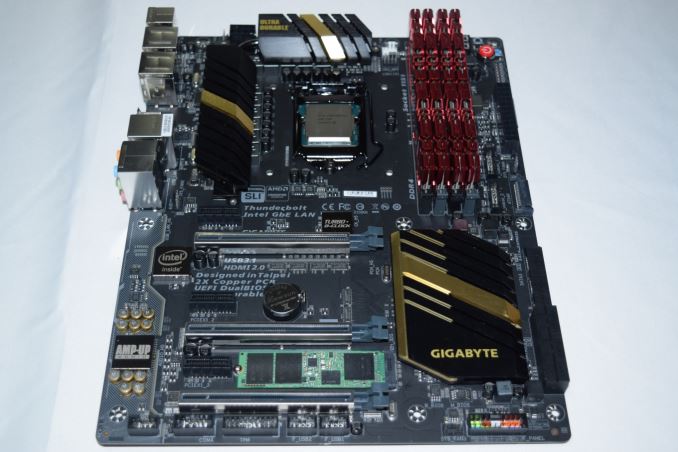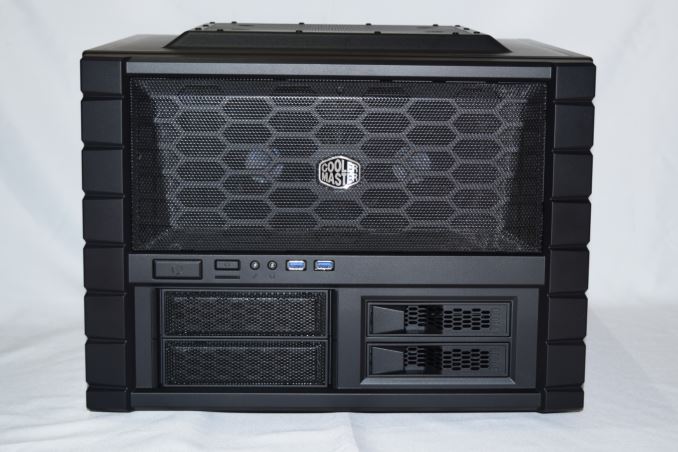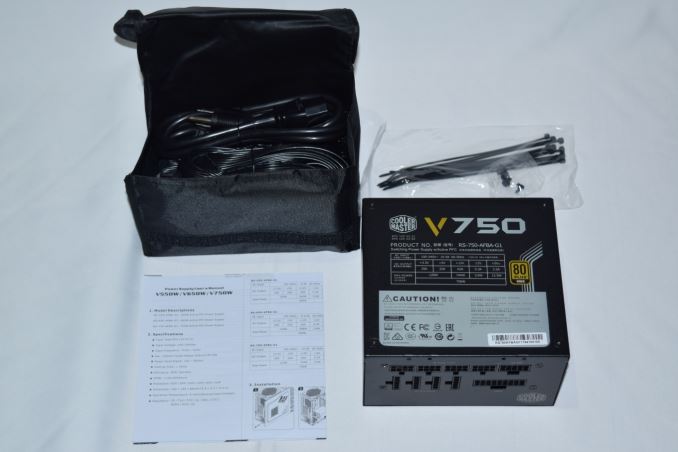Samsung Portable SSD T3 Review
by Ganesh T S on February 22, 2016 10:00 AM ESTThe Skylake DAS Testbed Build
The rising popularity of USB 3.1 (both Gen 1 and Gen 2) Type-C direct-attached storage (DAS) devices and the upcoming Thunderbolt 3 DAS units made it clear that I had to work on some updates to our direct-attached storage testbed. Originally based on the Haswell platform, the DAS testbed used a Thunderbolt 2 PCIe add-on card and the USB 3.0 ports hanging off the PCH. For a brief while, I also added USB 3.1 Gen 2 Type-A and Type-C PCIe cards to evaluate a few DAS units.
The introduction of Skylake has been quite interesting from the viewpoint of fast local storage. While the 100-series chipset doesn't have native USB 3.1 Gen 2 support, it does have plenty of high-speed PCIe 3.0 lanes that enable high-speed bridges to other protocols. Motherboard vendors have decided to enable USB 3.1 on entry-level boards with an ASMedia bridge chip. However, premium boards can be equipped with Intel's own Alpine Ridge controller.
Thunderbolt 3 and Intel's Apline Ridge are interesting for a few reasons (I will go more in detail into these in the review of our first Thunderbolt 3 DAS unit):
- In addition to Thunderbolt 3, Alpine Ridge also integrates a USB 3.1 Gen 2 (10 Gbps) host controller
- Thunderbolt 3 works over a Type-C interface, and supports a couple of additional protocols - USB 3.1 Gen 2 and DisplayPort 1.2
Considering these aspects, it made sense to migrate to Skylake for our DAS testbed. In particular, I looked out for a board with Alpine Ridge integrated. Ian published the review of the GIGABYTE Z170X-UD5 TH last Friday, and it turned out that the board perfectly fit the requirements. Intel provided us with a sample of the Core i5-6600K to use in the board. G.Skill also came forward with four 8GB DDR4 DIMMs to give the testbed 32GB of DRAM (the same as our Haswell-based testbed)
The Corsair Carbide Series Air 540 chassis in our Haswell-based testbed has been great in terms of footprint, ventilation and easy access to components. Two hot-swap internal SATA slots turned out to be a boon for quick secure erases of SSDs as well as benchmarking of internal HDDs meant for NAS usage in the single-disk mode. However, this unintended usage model (I wasn't planning on doing this frequently when I first opted for the Corsair Air 540) was a bit of a hassle, since one of the chassis sides had to be dismounted to access the hot-swap slots. I wanted to address this issue in the new testbed.
In the lookout for a ATX chassis for the new testbed, I had three main requirements:
- Hot-swap bays accessible without the need to open up the unit (similar to the drive slots in hot-swap NAS units)
- Portability in terms of being easy to shift from one location in the lab to another (something I realized as important when trying to test daisy chaining with a Thunderbot 2 DAS unit last year)
- Cubical footprint with horizontal motherboard orientation in order to better fit in a workbench and enable easy swapping out of PCIe cards in the future
The Cooler Master HAF XB EVO perfectly fit our requirements. The two X-Dock bays fulfilled our need for hot-swap bays for both 3.5" and 2.5" drives. Since the unit is marketed as a LAN box, it has two rigid carry handles on the side panels to enable portability. The unit can also easily serve as a testbench. Only the top cover (held in place by two screws at the back) needs to be removed in order to access the PCIe cards. The PSU slot also extends slightly out, enabling easier cable management inside the chassis. With plenty of additional drive slots in addition to the X-Dock, it was a no-brainer to go with the Cooler Master HAF XB EVO.
We have traditionally gone with the chassis vendor for the PSU also in our testbeds. Cooler Master suggested the fully modular V750 for use in our system.
Even though a 750W PSU is an overkill for a system with no discrete GPUs, the rating makes sure that we have the option in the future. The fully modular nature also helped greatly in cable management.
In addition to the above, we made use of a few components that were salvaged from earlier reviews / unused components from previous builds - a Corsair Hydro Series H105 liquid CPU cooler, a Samsung SM951 NVMe PCIe 3.0 x4 SSD for the boot drive, and an Intel 730 series 480 GB SSD and a Corsair Neutron XT 480 GB SSD for use as staging drives for temporary data. The gallery below provides some more pictures from our build process.
Evaluation of DAS units on Windows is being done with the testbed outlined in the table below. For devices with a USB 3.1 Gen 1 (USB 3.0 via a Type-C interface) connections (such as the Samsung Portable SSD T3 2TB that we are considering today), we utilize the USB 3.1 Type-C port enabled by the Intel Alpine Ridge controller. It connects to the Z170 PCH via a PCIe 3.0 x4 link..
| AnandTech DAS Testbed Configuration | |
| Motherboard | GIGABYTE Z170X-UD5 TH ATX |
| CPU | Intel Core i5-6600K |
| Memory | G.Skill Ripjaws 4 F4-2133C15-8GRR 32 GB ( 4x 8GB) DDR4-2133 @ 15-15-15-35 |
| OS Drive | Samsung SM951 MZVPV256 NVMe 256 GB |
| SATA Devices | Corsair Neutron XT SSD 480 GB Intel SSD 730 Series 480 GB |
| Add-on Card | None |
| Chassis | Cooler Master HAF XB EVO |
| PSU | Cooler Master V750 750 W |
| OS | Windows 10 Pro x64 |
| Thanks to Cooler Master, GIGABYTE, G.Skill and Intel for the build components | |
The list of DAS units used for comparison purposes is provided below.
- Samsung Portable SSD T3 2TB
- Corsair Voyager GTX v2 256GB
- LaCie Rugged Thunderbolt 500GB
- Samsung Portable SSD T1 1TB - No Encryption
- SanDisk Extreme 500 240GB - USB 3.0



















49 Comments
View All Comments
ganeshts - Wednesday, February 24, 2016 - link
That is the T1. I don't think there will be a issue with T3, because the security package comes for download online / is an installer present in the main partition itself.AnTech - Sunday, December 4, 2016 - link
Thanks. I purchased it. At least Samsung Portable SSD T3 500 GB is amazing. Boots Mac to work from it all day long at work and home, and does not even get hot. Not even warm. External metal enclosure remans cold. I have not seen that before. The internal Samsung 3D V-NAND is truly amazing!AnTech - Wednesday, February 24, 2016 - link
Can it be used to boot Mac and work from it all day long?AnTech - Wednesday, February 24, 2016 - link
RAID 0 inside as in SanDisk's 1.92TB Extreme 900 Portable SSD? That is the best way to lose data (2x probability or more). One disk fails (or controller), all lost.Unicron1000 - Thursday, February 25, 2016 - link
I have a T1 and while small and fast, it has some quirks -- and I can't use it the same way as a Samsung 840EVO SSD inside of a USB 3 enclosure.I couldn't format it with Disk Utility on Mac out of the box. And the only way to eject it was Force Eject on El Capitan. I had to use its janky proprietary formatting program that crashed constantly to format it.
When formatted in Windows 8 to FAT32 or exFAT, a Playstation 4 won't recognize it. Does the T3 fix these quirky shortcomings? (I'm guessing it's the hardware encryption on the T1 that makes it such a fussy devil)
DieterH - Monday, April 25, 2016 - link
I own a new 1T Samsung drive, can I install the drive into this enclosure?MrHorizontal - Monday, August 1, 2016 - link
I see the NAND packages are on a daughterboard - is that daughterboard actually m.2 SATA or mSATA per chance?FrenchTech - Monday, January 29, 2018 - link
As a photographer and video maker based in Paris, I bought the Samsung T3 for its compact size and high speed. Unfortunately, this drive has failed on my twice already — on the only two major trips I took it on — though it worked flawlessly at my desk and around town for months. I just don’t understand it. Nothing like this has ever happened to me on any other of the many drives I use!The first time it failed totally — neither readable nor writable. But it did power up, and when I called my seller once I was back, he convinced me to just reformat it and it would be fine. Months later it failed again, only this time, it could be read (not all but most files) but couldn’t be written to. This is where I’m at now, just back from 7 weeks in India, and wondering what to do with this cute little treacherous gadget...
Has anyone gotten any other feedback like this? What could be happening? In both cases I had made a lot of changes to what was on the disk, deleting and adding files and folders just before leaving. But so what? That’s what an external HD is for. All I know is I can’t trust this one ever again. In both cases I was lucky to find a place to buy another drive in a faraway land, and was lucky too that no files were lost, since I never save anything in only one place. Still this is weird, and expensive.
Can anyone be of any help?